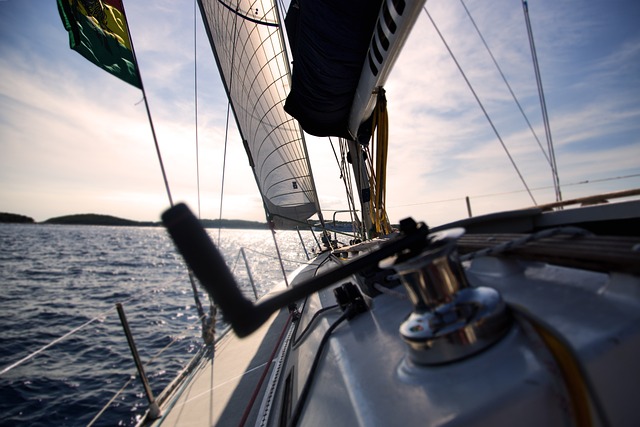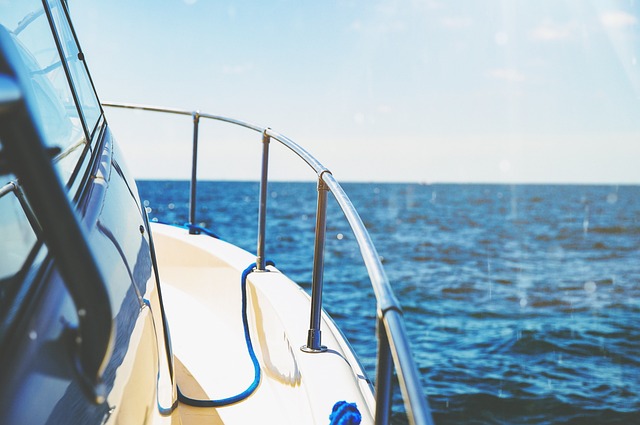Marine batteries are vital for reliable vessel operation, enduring maritime conditions that include salty environments, vibrations from engines, and wide temperature fluctuations. Understanding the differences between lead-acid, AGM (Absorbed Glass Mat), and SLA (Sealed Lead-Acid) batteries is key for optimal performance and longevity at sea. AGM and SLA batteries offer superior shock and vibration resistance, as well as consistent charge retention across a range of temperatures, handling deep discharges with less impact on their lifecycle. When selecting a marine battery, it's important to consider the battery's capacity, amp-hour rating, and the electrical loads it will support.
Sustainable power solutions for marine batteries include solar charging systems with PV panels and charge controllers, offering silent, emission-free charging and reducing reliance on fossil fuels. These systems are adaptable to various energy needs and weather conditions, cutting down on maintenance and extending the time between recharging at marinas. Wind turbines also provide a clean, eco-friendly charging alternative, harnessing wind energy to power marine batteries, particularly useful for offshore sailors.
For continuous charging, engine-driven chargers are robust and reliable, working in tandem with the vessel's engine to prevent battery depletion. Selecting the right portable battery charger or jump starter, designed specifically for marine environments, is crucial for convenience, safety, and extended battery life. Proper care includes regular inspection, water topping, terminal maintenance, and smart charging to maintain peak performance and longevity of your marine battery. Regular monitoring of charge patterns, storing in cool, dry places, and professional servicing are also recommended for optimal maritime power solutions.
Embarking on a nautical journey requires robust power sources, and understanding how to effectively charge your boat’s batteries is crucial for any mariner. This article delves into the top five methods for charging boat batteries, ensuring you can navigate the high seas with confidence. From the latest in sustainable solar charging systems to harnessing the natural wind with turbines, and utilizing alternators for continuous onboard charging, we explore a variety of solutions tailored for marine battery care. Additionally, we examine portable chargers and jump starters that offer versatile backup power options. With a focus on practical advice and maintenance tips, your boat’s batteries will remain reliable for countless adventures at sea.
- Understanding Marine Battery Types and Requirements
- Solar Charging Systems for Sustainable Marine Battery Power
- Wind Turbines: Harnessing Natural Wind for Efficient Boat Battery Charging
- Utilizing Alternator and Engine Driven Chargers for Continuous Onboard Charging
- Portable Battery Chargers and Jump Starters: Versatile Marine Battery Solutions
- Maintenance and Care for Long-Term Marine Battery Performance
Understanding Marine Battery Types and Requirements

When addressing the needs of a vessel, understanding the types and requirements of marine batteries is paramount. Marine batteries are specifically designed to withstand the unique demands of nautical environments, which often include harsh salts, frequent vibrations from engine operations, and varying temperatures that both fluctuate and extreme conditions can prevail. These factors necessitate robust construction and durable materials for the best performance and longevity. There are primarily two types of marine batteries: lead-acid and absorbed glass mat (AGM) or sealed lead-acid (SLA) batteries. Lead-acid batteries, while historically used in marine applications, have largely been supplanted by AGM and SLA due to their superior resistance to vibration and shock, along with their ability to hold a charge over a wide range of operating temperatures. Additionally, these advanced batteries are designed to handle deep discharges without compromising their lifecycle or performance. Users must consider the battery type’s capacity, amp-hour rating, and the type of loads it will power, whether for starting the engine or for deep-cycle applications like trolling or running electronics. Knowledge of these aspects ensures that mariners select the correct marine battery to meet their specific needs on the water.
Solar Charging Systems for Sustainable Marine Battery Power

Solar charging systems offer a sustainable and eco-friendly solution for charging marine batteries, making them an ideal choice for boat owners who are conscious about their environmental impact and wish to minimize reliance on fossil fuels. These systems harness the power of the sun through photovoltaic (PV) panels, which are then converted into usable electricity by a charge controller. This energy can be stored in marine batteries, providing a renewable source of power for various onboard operations, from navigation systems to cabin lighting.
The integration of solar charging systems with marine batteries is both cost-effective and efficient over time. Unlike traditional charging methods that may involve running a generator or connecting to shore power, solar charging is silent, emission-free, and requires minimal maintenance. It’s also highly adaptable, as the size and number of PV panels can be tailored to match the energy needs of the boat, ensuring optimal performance regardless of weather conditions or seasonal variations. By leveraging the abundant solar energy available at sea, these systems can significantly extend the time between necessary marina visits for battery recharging, making them a practical and sustainable upgrade for any vessel.
Wind Turbines: Harnessing Natural Wind for Efficient Boat Battery Charging

Wind turbines offer a sustainable and cost-effective solution for charging marine batteries on boats, leveraging the natural wind present at sea. By installing a wind turbine system on your vessel, you can harness kinetic energy from the wind to generate electricity. This renewable energy source is particularly beneficial for offshore sailors who are away from traditional power grid connections for extended periods. The generated electricity can be used directly or stored in marine batteries, ensuring that your boat’s electrical systems remain operational without relying on fossil fuels. Additionally, wind turbines are low-maintenance and have a minimal environmental impact, making them an environmentally friendly option. When optimized, they can significantly reduce the reliance on alternative charging methods like shore power or gasoline-powered generators. Boaters looking to integrate wind turbines for their marine batteries should consider factors such as the boat’s sailing profile, average wind conditions, and the size of the battery bank to select the most appropriate turbine model and size for their specific needs. This not only enhances the sustainability of your boating experience but also contributes to the longevity of your marine batteries by ensuring they are charged with clean energy.
Utilizing Alternator and Engine Driven Chargers for Continuous Onboard Charging

When it comes to maintaining the health and performance of your marine battery, utilizing an alternator or engine-driven charger is a reliable method for continuous onboard charging. These systems are designed to work seamlessly with your boat’s engine, providing a steady charge as you operate the vessel. An alternator, which is directly connected to the engine, generates electrical current while the engine is running, effectively topping up the marine battery without any additional input from the operator. This method is particularly advantageous for long journeys or frequent use, as it ensures that your battery remains fully charged and ready for use, preventing the deep discharges that can shorten a battery’s lifespan.
Furthermore, alternator and engine-driven chargers are robust and built to withstand the maritime environment, which is often exposed to saltwater, moisture, and vibrations. They are specifically tailored for marine applications, offering ample current to charge a range of batteries from small trolling motors to large deep-cycle units. To maximize the efficiency of these systems, it’s important to select a charger with the correct output specifications for your battery type and size. Properly maintaining your marine battery through continuous onboard charging not only extends its lifespan but also ensures that you have reliable power when you need it most, whether you’re navigating open waters or anchored in a secluded cove.
Portable Battery Chargers and Jump Starters: Versatile Marine Battery Solutions

When it comes to maintaining a vessel’s power supply, portable battery chargers and jump starters stand out as versatile solutions for marine battery care. These devices are invaluable for boat owners, offering convenience and reliability whether you’re on the open sea or docked. A high-quality marine battery charger can revive a depleted battery with ease, ensuring your boat’s electrical systems are always ready for use. The key to selecting an ideal portable charger lies in its compatibility with your boat’s specific battery type, whether it be lead-acid, AGM, or lithium. These chargers often come with multiple charging modes and smart technology that automatically selects the best charging method for your marine battery, ensuring optimal performance and longevity. Moreover, they are designed to be durable and waterproof, meeting the rigorous demands of a maritime environment.
Jump starters for marine batteries offer an additional layer of security by providing a jump-start when your boat’s starting battery is too weak to start the engine on its own. These devices are particularly useful in emergency situations or when your vessel has been idle for an extended period. They can be compact and easily stored, yet powerful enough to kickstart even the largest of engines. With features like built-in cables and clamps that are specifically designed for marine applications, these jump starters ensure a secure and efficient connection every time. Additionally, some models come with extra functions such as an air compressor for checking tire pressure or USB ports for charging electronic devices, making them multifunctional tools for any boater’s arsenal. Investing in a reliable portable battery charger or jump starter can mean the difference between a pleasurable outing and a stranded experience on the water, making them essential additions to your boat’s equipment list.
Maintenance and Care for Long-Term Marine Battery Performance

When it comes to maintaining and enhancing the long-term performance of your marine battery, consistent care and proactive maintenance are key. Regularly checking the water levels in flooded lead-acid batteries is a fundamental aspect of upkeep; ensure that the electrolyte solution remains at the proper specific gravity and that the water is clean and distilled to avoid contamination. Keeping the terminals clean and free from corrosion is another critical element, as this can significantly impede battery performance over time. Use a mixture of baking soda and water to gently clean the terminals, followed by a thorough rinse with plain water.
Monitoring the charge and discharge cycles is also essential for the longevity of your marine battery. Avoid letting the battery fully deplete unless absolutely necessary, as this can shorten its lifespan. Instead, maintain a regular charging routine that keeps the battery between 50% to 80% state of charge. Additionally, storing the battery in a cool, dry place, away from direct sunlight and extreme temperatures, will protect it against premature aging and loss of efficiency. Employing a marine battery charger with automatic voltage regulation can further ensure that your battery is charged optimally, thus maintaining its capacity to hold a charge for extended periods on the water. Regular servicing by a professional can also help in diagnosing any potential issues before they become major problems, ensuring your marine battery remains reliable and performs at its best.
When maintaining a vessel’s power needs, understanding and implementing effective charging solutions for your marine battery is paramount. This article has explored the top five ways to charge boat batteries, from leveraging sustainable solar and wind energy sources to utilizing onboard alternators and portable chargers. Each method offers unique advantages, catering to various boating scenarios and preferences. By integrating these strategies, boat owners can ensure their marine batteries are consistently charged and ready for use. Proper selection and maintenance of the right battery type for your needs, along with regular care, will extend its lifespan and reliability. With these methods at hand, you’re well-equipped to keep your marine electrical systems operational, enhancing both safety and comfort on the water.
